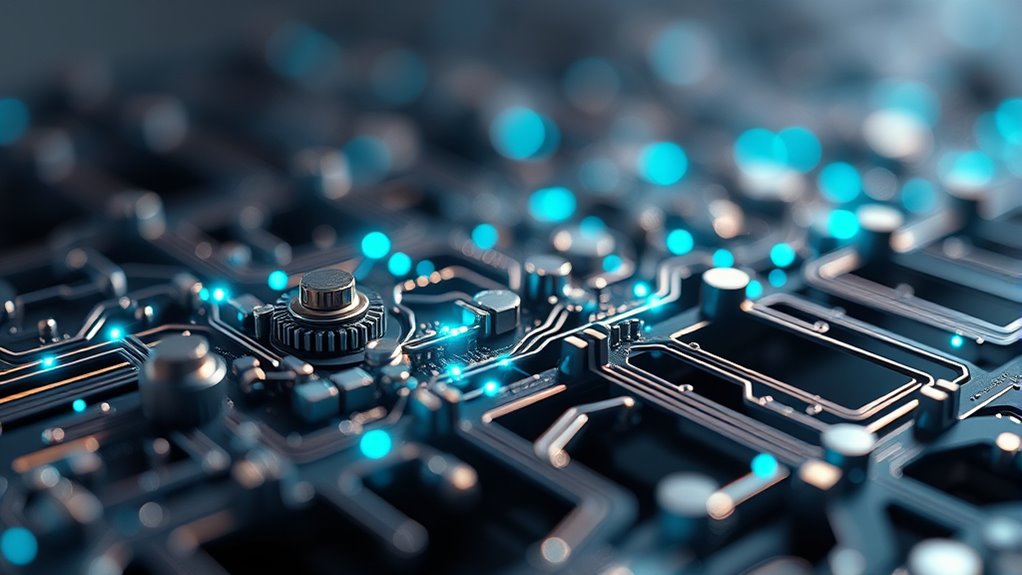Atomic precision in nanomachines means you can manipulate matter at the most fundamental level, enabling you to design highly specialized and efficient devices. Advances in nanotechnology and molecular assembly techniques allow you to position atoms accurately, creating complex nanostructures previously impossible. High-resolution imaging helps verify these arrangements, while quantum control enhances their functionality. By mastering atomic precision, you open the door to groundbreaking innovations across medicine, energy, and manufacturing—if you keep exploring, you’ll discover how these tiny machines are transforming the future.
Key Takeaways
- Atomic precision enables the assembly of nanomachines with exact molecular configurations for specific functions.
- Advanced imaging techniques verify atomic arrangements, ensuring high accuracy in nanomachine construction.
- Quantum control techniques manipulate atomic and quantum states to optimize nanomachine performance and behavior.
- Atomic-level manipulation allows creation of complex nanostructures for targeted applications like medicine and energy.
- Ongoing innovations in atomic precision drive the development of highly efficient, functional nanodevices at the nanoscale.

Advancements in nanotechnology have enabled scientists to achieve atomic precision in designing and constructing nanomachines. This leap forward opens up incredible possibilities, especially in how these tiny devices are built and operated. At the core of this progress is your ability to manipulate matter at the atomic level, allowing for highly accurate molecular assembly. You can now position individual atoms with remarkable precision, creating structures that were once thought impossible. This precision isn’t just about stacking atoms; it’s about understanding and controlling the interactions between them to build functional nanomachines. When you focus on molecular assembly, you’re essentially orchestrating a complex dance of atoms, guiding them into specific arrangements to serve a purpose—whether for targeted drug delivery, energy storage, or nanoscale manufacturing. This meticulous process demands an understanding of both the chemistry and physics at play, and recent innovations have considerably improved your capability to achieve it. Additionally, high-resolution imaging techniques enable you to verify and refine atomic arrangements with unprecedented accuracy, further advancing nanomachine development.
Alongside molecular assembly, quantum control plays an indispensable role in refining how nanomachines operate at the most fundamental level. Quantum control involves manipulating the quantum states of particles to achieve desired behaviors, such as precise movement or energy transfer within nanodevices. You can harness these quantum effects to fine-tune the performance of nanomachines, making them more efficient and adaptable. For example, controlling electron states at the quantum level allows you to optimize energy flow within a nanomachine, reducing losses and enhancing functionality. This ability to manipulate quantum phenomena grants you unprecedented control over how nanomachines function, enabling the development of devices that can perform complex tasks with high precision. It also provides a foundation for integrating these devices into larger systems, where quantum effects can be exploited for enhanced capabilities.
Frequently Asked Questions
How Do Nanomachines Communicate at the Atomic Level?
You can think of nanomachines communicating at the atomic level through quantum tunneling, which allows particles to pass through barriers, enabling signal transduction. When a nanomachine detects a change, it triggers electrons or other particles to move via tunneling, transmitting information rapidly. This process lets nanomachines coordinate actions precisely, using atomic-scale signals that facilitate complex functions essential for their roles in medicine, manufacturing, or environmental sensing.
What Are the Ethical Considerations of Atomic-Scale Manipulation?
You should consider the moral implications of manipulating materials at the atomic level, as it raises questions about safety, unintended consequences, and environmental impact. Regulatory challenges also come into play, since existing laws may not cover such advanced technology. By addressing these ethical concerns early, you help guarantee responsible development, prevent misuse, and promote trust in nanotechnology’s potential benefits while minimizing risks to society and the environment.
Can Atomic Precision Be Maintained in Biological Environments?
Think of atomic precision in biological environments like trying to keep a delicate snowflake intact in a storm. You can maintain this precision, but you’ll face biocompatibility challenges that may cause reactions or damage. Environmental stability becomes tricky because biological fluids and temperatures can interfere with atomic-scale structures. With careful design and advanced coatings, you can enhance stability and compatibility, ensuring your nanomachines perform reliably inside living systems.
How Long Do Atomic-Scale Nanomachines Typically Operate?
Atomic-scale nanomachines typically operate for varying durations depending on their design, molecular stability, and energy consumption. You can expect them to function from seconds to hours, as their stability relies on precise atomic interactions. Their energy needs influence operation time—more efficient systems last longer. To maximize lifespan, optimizing molecular stability and minimizing energy consumption are vital, allowing you to extend their operational periods in practical applications.
What Are the Future Applications of Atomic Precision Technology?
Think of atomic precision technology as a key unblocking future possibilities. You’ll see quantum control enable breakthroughs in medicine, manufacturing, and energy. Material innovation will lead to stronger, lighter, and more adaptable substances. You could harness nanomachines to repair cells at the molecular level or create ultra-efficient batteries. As you explore, you’ll find that these advances will transform industries, making everyday life smarter, healthier, and more sustainable.
Conclusion
You stand at the edge of a universe where tiny gears and atoms dance with perfect harmony, each move precise as a heartbeat. As you manipulate these nanomachines, you see a cosmos crafted from shimmering particles, glowing with potential. Every atom aligns like stars in a clear night sky, promising breakthroughs beyond imagination. In this domain of atomic precision, you hold the power to shape the future, building miracles one molecule at a time, where dreams become reality amid the intricate beauty of the nanoscale.









